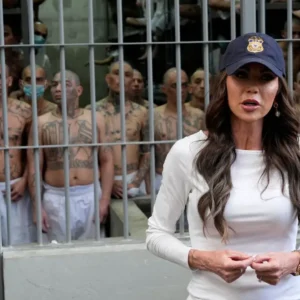In a move that has sent shockwaves through the entertainment industry, President Donald Trump has announced plans to impose a 100 percent tariff on movies produced outside the United States, declaring the decline of domestic film production a “national security threat.” This dramatic intervention in one of America’s most influential cultural exports comes amid escalating trade tensions with China and represents the latest in Trump’s America-first economic policies. While the president frames the measure as necessary to revitalize Hollywood, industry experts are questioning both the feasibility and wisdom of such an unprecedented approach to what has become an increasingly global business.
The Presidential Decree: Hollywood in Peril
The announcement came via Trump’s Truth Social platform, where the president characterized the American movie industry as being in dire straits. “The Movie Industry in America is DYING a very fast death. Other Countries are offering all sorts of incentives to draw our filmmakers and studios away from the United States,” Trump wrote. “Hollywood, and many other areas within the U.S.A., are being devastated.”
What particularly stood out in Trump’s declaration was his framing of the issue not merely as an economic concern but as a matter of national security. “This is a concerted effort by other Nations and, therefore, a National Security threat. It is, in addition to everything else, messaging and propaganda!” This characterization elevates what might otherwise be seen as a routine trade dispute to a matter of strategic importance for the United States.
The solution, according to the president, is a sweeping tariff that would dramatically increase the cost of foreign-produced films entering the American market. “Therefore, I am authorizing the Department of Commerce, and the United States Trade Representative, to immediately begin the process of instituting a 100% Tariff on any and all Movies coming into our Country that are produced in Foreign Lands. WE WANT MOVIES MADE IN AMERICA, AGAIN!”
Commerce Secretary Howard Lutnick responded promptly to the president’s announcement on social media, stating simply: “We’re on it.” However, neither Lutnick nor Trump provided immediate details on how such a tariff would be implemented or the timeline for its introduction.
This latest announcement represents a significant escalation in Trump’s broader trade strategy. It follows the administration’s imposition of substantial tariffs on various imports, including a universal 10 percent tariff on most goods entering the United States, a 25 percent tariff on steel and aluminum, and a massive 145 percent tariff on imports from China. The movie industry, previously unaffected by these measures, now finds itself squarely in the president’s sights.
Understanding “Runaway Production”: Why Hollywood Left Home
To comprehend the context of Trump’s announcement, one must understand the phenomenon of “runaway production” – the film industry term for when American productions are shot outside the United States. This trend has been growing for decades, reaching a point where major Hollywood blockbusters routinely shoot in locations like Canada, the United Kingdom, Australia, New Zealand, and Eastern Europe.
The primary driver behind this exodus is financial. According to reports, movie and TV production has been steadily leaving Hollywood for years, heading to locations with tax incentives that make filming significantly cheaper. Globally, governments have increased credits and cash rebates to attract productions, competing for a share of the estimated $248 billion that will be spent worldwide on content production in 2025.
This trend began in earnest in the late 1990s, when Canada pioneered the first substantial production incentives for filmmakers. Canada’s introduction of these incentives in 1997 led to “a surge of productions migrating to the North from the U.S.” In response, Louisiana became the first U.S. state to adopt production incentives in 2001, beginning a competitive race among states to attract film production. Today, the incentives offered by countries and regions around the world have become increasingly generous.
For example, in the United Kingdom, films can claim a cash rebate of up to 25 percent of qualifying production expenditure. Similar schemes operate in countries like Ireland, Australia, New Zealand, and across Eastern Europe. Even within the United States, states like Georgia, New York, and New Mexico have developed aggressive tax incentive programs to draw productions away from California.
The economics are compelling for studios. When a production can save millions or even tens of millions of dollars by shooting overseas or in another state, the financial pressure to leave Hollywood becomes intense. Major Hollywood studios have come to depend on these overseas incentives as a way to reduce production costs. In an industry where production budgets for major films routinely exceed $200 million, these savings are too significant to ignore.
The Hollywood Ambassador Initiative: Setting the Stage
Trump’s tariff announcement doesn’t come in isolation. It follows the president’s January appointment of three Hollywood actors – Jon Voight, Mel Gibson, and Sylvester Stallone – as “special ambassadors” to the entertainment industry. As Trump explained at the time, “They will serve as Special Envoys to me for the purpose of bringing Hollywood, which has lost much business over the last four years to Foreign Countries, BACK—BIGGER, BETTER, AND STRONGER THAN EVER BEFORE!”
All three actors have been vocal supporters of Trump. Stallone introduced the President at a Mar-a-Lago gala in November, calling him the “second George Washington”; Gibson voiced his support for Trump and criticized Kamala Harris ahead of the 2024 election; and Voight has spoken extensively about his admiration for Trump. According to industry sources, these “ambassadors” – particularly Jon Voight – have been actively working behind the scenes on proposals to boost domestic film production.
Several sources told The Hollywood Reporter that Voight is the instigator of Trump’s sudden interest in film production, taking meetings with leaders of Hollywood guilds and studios about proposing a domestic film incentive to Trump. Interestingly, the president appears to have interpreted that advice through his preferred policy lens – using tariffs as a stick rather than incentives as a carrot. This approach runs counter to what many in the industry had anticipated from the ambassador initiative, which was expected to focus more on creating competitive domestic incentives rather than penalizing foreign production.
The Practical Challenges: Can Movie Tariffs Even Work?
While Trump’s announcement sent tremors through Hollywood, many industry experts are questioning whether such a tariff is practically feasible or legally sound. Unlike physical goods, movies are intellectual property and represent a type of service that has not traditionally been subject to tariffs.
As CNN Business noted, “It’s not at all clear how such a tariff would be imposed. Films are intellectual property, not goods, so they represent a kind of service that is not currently subject to tariffs.” This creates a fundamental implementation challenge – there’s no established mechanism for applying tariffs to film content.
Further complicating matters is the complex, multinational nature of modern film production. Many movies are shot in multiple countries, with different elements of production taking place across various locations. For U.S. companies that film overseas, it’s not clear what transaction would be tariffed. When Disney makes a movie abroad, it doesn’t “import” the movie from itself for a particular fee to show on U.S. screens.
Industry Reaction: Confusion, Concern, and Potential Consequences
The announcement has left Hollywood executives, producers, and analysts scrambling to understand its implications. So far, the official industry response has been muted. A spokesperson for the Motion Picture Association, which represents the major studios, declined to comment on the proposal.
Privately, however, industry figures express significant concerns about the potential impact on an already challenged business. The domestic box office has not fully recovered from the COVID-19 pandemic, and the 2023 writers’ and actors’ strikes created additional financial pressures. Adding the complexity and potential costs of a tariff system could further strain studio finances.
Some experts warn that rather than increasing domestic production, the tariff could have the opposite effect. William Reinsch, a former senior Commerce official, cautioned that “retaliation will kill our industry. We have a lot more to lose than to gain.” The concern about potential retaliation is well-founded. The American film industry has historically enjoyed a substantial trade surplus, with Hollywood movies generating far more revenue internationally than foreign films earn in the U.S. market.
Conclusion: An Uncertain Plot Twist for Hollywood
Donald Trump’s proposed 100 percent tariff on foreign-produced films represents one of the most dramatic government interventions in the American film industry in recent memory. While framed as a measure to revitalize Hollywood and bring production jobs back to the United States, the proposal raises significant questions about implementation, effectiveness, and potential unintended consequences.
The film industry now finds itself at a crossroads, caught between competing economic pressures, evolving viewer habits, and now, direct government intervention. How studios, streaming platforms, and international partners respond will shape not just the business of moviemaking but potentially the content and character of the films themselves.
As Commerce Secretary Lutnick and the U.S. Trade Representative begin the process of developing this policy, all eyes in Hollywood will be watching for details that could determine whether this bold gambit successfully brings production back to American soil or creates new complications for an industry already navigating significant challenges.





